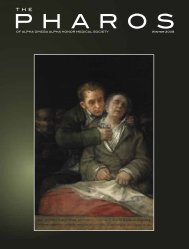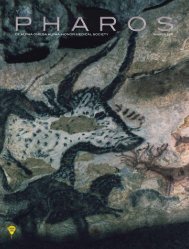Download Selections from The Pharos Autumn 2004 Edition
Download Selections from The Pharos Autumn 2004 Edition
Download Selections from The Pharos Autumn 2004 Edition
- No tags were found...
Create successful ePaper yourself
Turn your PDF publications into a flip-book with our unique Google optimized e-Paper software.
What do we mean by “the art of medicine”?unquantifiable clinical competency based on experience, or,as one citation above suggests, to deficits in the scientificmethods we hold so dear? Language reflects the people whouse it. <strong>The</strong> phrases we employ reflect something about how weview ourselves as caregivers. Several authors have attemptedto formulate their own definitions of “the art of medicine” fortheir own purposes; 4,5 but no one has explicitly defined theterm for all.Medicine . . . recognized earlyas a science<strong>The</strong> concept of medicine as an “art” originated in thesecond half of the fifth century B.C., the same period duringwhich medical practice began to break its ties to pagan theologyand ritual. 6 Philosophers established rigorous new rulesfor intellectual disciplines such as rhetoric and history, andalso for trade skills such as shipbuilding or navigation. Witha surprisingly extensive body of literature behind it, medicinetoo became one of the technai, a Greek term for “art” thatalso contained an idea of rigorous method in application, andthe root of our word technology.* Detractors responded thatmedicine should not be included among the technai, becausesome patients recover without medical intervention, whileothers die despite physicians’ best efforts. Medicine, theyargued, does not truly exist, since its outcomes are based, noton skill, but solely on chance.Among the writings attributed to Hippocrates is a treatiseentitled De arte, a fierce defense of all the technai and anepistemological argument for medicine’s place among them. 6,7What makes medicine an art, he wrote, and what makes thetechnai intellectually valuable to man, is that the practice ofthese disciplines is not left to chance but is indeed governedby specific principles. De arte is, in fact, an early characterizationof a kind of scientific method.At that time, significant debate surrounded the role of ethicsin the application of the technai. Scholars asked whetherthe practitioner of the technai should sustain a semblance ofvirtue in his practice in order to reach virtuosity in his art. 8 (Ifa shipbuilder builds a strong and powerful ship, does it matterif his morals are suspect?) Pythagorean philosophers (among* A variety of translations of the word techne (singular form oftechnai) can be found in contemporary Greek-English dictionaries,including “art,” “artistry,” “craft,” “liberal arts,” and “applied skill.” Thispaper employs the suggestion by Leon Kass that techne is “a termhard to translate, but perhaps best rendered as ‘art’ if one remembersthat it meant primarily the useful arts and handicrafts and only latterly,if at all, the fine arts.” 8p216others of that era) generally agreed that physicians shouldaspire to practice medicine not only with technical prowess,but with moral guidance—hence, the origin of the HippocraticOath. 9 <strong>The</strong>refore, as a concept, “the art of medicine” evolved tocontain both elements—technical skill and moral sensibility.Medicine . . . both art and scienceOf course, ideas about the nature of art and the natureof science evolved through time. Over two millennia later,William Osler promulgated the concept that art and scienceconstitute distinct entities, and that good medical practicecontains both of them. “<strong>The</strong> practice of medicine,” Osler wrote,“is an art, based on science.” 10p119 This implies a notion thatscience, and therefore the scientific method, is a set of toolsfor clinical practice. Almost 40 years later, physician FrancisPeabody echoed this idea: “[Medicine] is an art, based to anincreasing extent on the medical sciences, but comprisingmuch that still remains outside the realm of any science.” 11p877For Osler and Peabody, aspects of clinical practice straying<strong>from</strong> the natural sciences, while reaching out to the individualpatient, compose elements of the “art.” Osler wrote, “[F]romthe standpoint of medicine as an art for the prevention andcure of disease, the man who translates hieroglyphics of scienceinto the plain language of healing is certainly the moreuseful.” 10p115 This vague, humanistic notion of “art” seems remarkablydifferent <strong>from</strong> the rigid concepts defined in ancientGreece (recall that the ethics of patient care proposed by theHippocratic Oath are written as strict mandates).What really is meant by “the art ofmedicine”?A Medline keyword search for the phrase “art of medicine”results in 235 entries since 1965: 188 citations in Englishlanguagejournals, the remaining 47 citations in journals<strong>from</strong> 11 different primary languages, including Norwegian (14citations), German (11), Swedish (7), Spanish (5), French (2),Danish (2), Serbo-Croatian (2), and Italian, Japanese, Polish,and Russian (one each). While the process of abstract translationinto English may account for occasional uses of the term“art of medicine,” it is more likely that this variety of linguisticcultures reflects a common concept implied by the phraseitself, regardless of language. For example, in one trilingualjournal, “the art of medicine” translates neatly into German“kunst der medizin”; 12 in a Spanish language journal, the authordescribes empathy as “la quintaesencia del arte de lamedicina” (“the quintessence of the art of medicine”). 13<strong>The</strong> <strong>Pharos</strong>/<strong>Autumn</strong> <strong>2004</strong>














